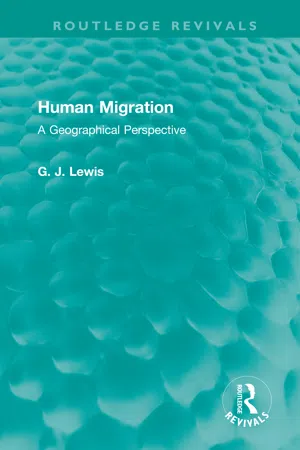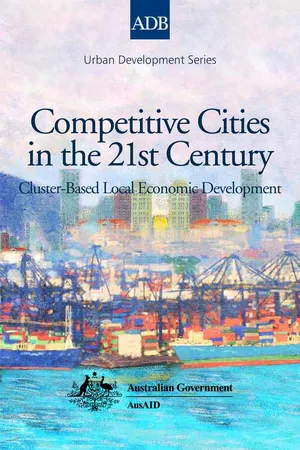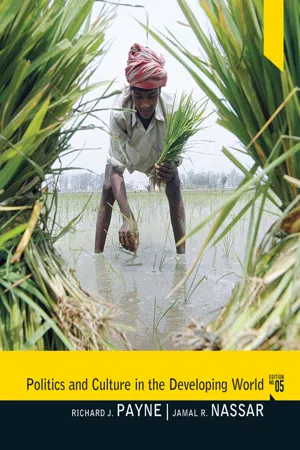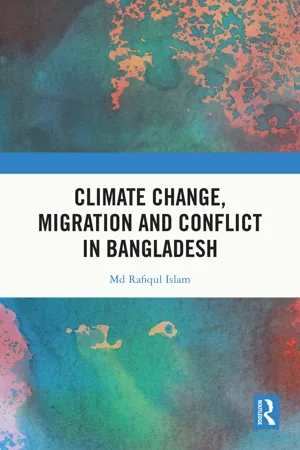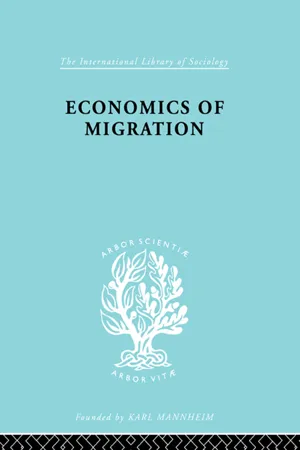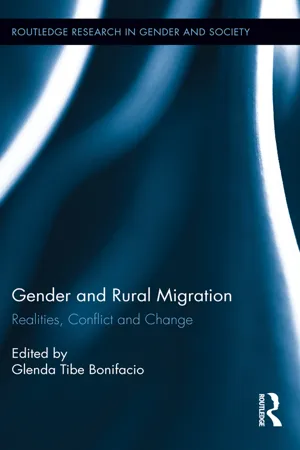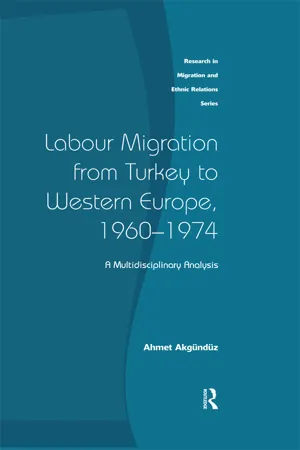Geography
Pull Factors of Migration
Pull factors of migration are the conditions or opportunities in a destination that attract people to move there. These factors can include better job prospects, higher wages, improved living standards, political stability, and access to education and healthcare. Pull factors play a significant role in influencing migration patterns and the distribution of population around the world.
Written by Perlego with AI-assistance
Related key terms
Related key terms
1 of 4
Related key terms
1 of 3
8 Key excerpts on "Pull Factors of Migration"
- eBook - ePub
Human Migration
A Geographical Perspective
- Gareth J. Lewis(Author)
- 2021(Publication Date)
- Routledge(Publisher)
As long ago as 1938 Herberle (1938) argued that migration is caused by a series of forces which encourage an individual to leave one place (push) and attract him to another (pull). In other words, if an individual’s needs cannot be satisfied at his present location, then a move elsewhere may be considered. On the other hand, despite being satisfied with his present situation, information about greater opportunities elsewhere may persuade the individual to move. For each migration, however, several push and pull forces may be operating and interacting, so that the move cannot be attributed wholly to either force. However, by examining large migration flows, the common stimulants to movement may be established. Bogue has succinctly summarized these ‘push-pull’ forces as follows:Push factors
(1) Decline in a national resource or in the prices paid for it; decreased demand for a particular product or the services of a particular industry; exhaustion of mines, timber or agricultural resources.(2) Loss of employment resulting from being discharged for incompetence, for a decline in need for a particular activity, or from mechanization or automation of tasks previously performed by more labour-intensive procedures.(3) Oppressive or repressive discriminatory treatment because of political, religious or ethnic origins or membership. (4) Alienation from a community because one no longer subscribes to prevailing beliefs, actions or mode of behaviour — either within one’s family or within the community. (5) Retreat from a community because it offers few or no opportunities for personal development employment or marriage. (6) Retreat from a community because of catastrophe — floods, fire, drought, earthquake or epidemic.Pull factors
(1) Superior opportunities for employment in one’s occupation or opportunities to enter a preferred occupation. (2) Opportunities to earn a larger income. (3) Opportunities to obtain desired specialized education or training such as a college education. (4) Preferable environment and living conditions — climate, housing, schools, other community facilities. (5) Dependency — movement of other persons to whom one is related or betrothed, such as the movement of dependents with a bread-winner or migration of a bride to join her husband.(6) line of new or different activities, environment or people, such as the cultural, intellectual or recreational activities of a large metropolis for rural and small-town residence (Bogue, 1969, 753-4). - eBook - ePub
Competitive Cities in the 21st Century
Cluster-Based Local Economic Development
- Kyeong Ae Choe, Brian H. Roberts(Authors)
- 2011(Publication Date)
- Asian Development Bank(Publisher)
The cities have become magnets for people from the rural areas and other countries by virtue of their economic advantages. Push–pull factors, or drivers between rural and urban areas, greatly affect spatial form, land use, and economic development patterns in Asian cities. While these factors are associated with migration to cities (Jaffee 1998), they are also related to demand- and supply-side factors that affect the economic development of cities and city regions (Blair and Reese 1999). This subsection discusses some of the more consequential push–pull factors affecting the spatial and economic agglomeration of cities. Push factors propel people to leave the rural areas (Jaffee 1998). Contributing to the push for rural–urban migration are the limited opportunities for suitable gainful employment in the countryside, the fragmentation of farmland and ownership, overcrowding, poverty, civil war and unrest, soil erosion, poor-quality housing, and the lack of basic services and community facilities, especially in countries like Pakistan, the Philippines, and Sri Lanka. Pull factors, on the other hand, encourage people to settle in urban areas (Jaffee 1998). Features of the urban environment relative to rural areas, such as income opportunities, higher wages, industrial jobs, a better standard of living, and kinship ties, are pull factors. These are also related to demand-driven factors, as well as to government policies and initiatives that are meant to generate demand and attract investment. Many governments have implemented a range of rural development policies to slow the movement of people to the cities. Others have adopted strong anti-urbanization policies; for example, would-be migrants to cities in the PRC, India (Mishra 2007), and Viet Nam must have migration permits - eBook - ePub
- Richard J. Payne, Jamal R. Nassar(Authors)
- 2015(Publication Date)
- Routledge(Publisher)
3 Push factors are generally negative developments and circumstances that motivate people to leave their homes. These include human rights violations, forced resettlement programs, poverty, natural and environmental disasters, and the lack of educational and cultural opportunities. Many Mexicans migrate to the United States because they cannot compete with highly subsidized U.S. grain exports to Mexico under the North American Free Trade Agreement (NAFTA). Pull factors, which also attract people away from their homes, include employment opportunities, political and social stability, and family reunification.push factors ■ The factors that motivate people to leave their homes, such as human rights violations, violence, and political instability.pull factors ■ The factors that motivate people to leave their homes, such as employment opportunities, higher wages, and educational opportunities.PUSH FACTORS
The United States was settled by people who sought religious and political freedom. During the Cold War, many Europeans came to the United States to escape oppressive governments. The large influx of Cuban immigrants to Florida and other parts of America resulted from Cuba’s system of communism under the leadership of Fidel Castro. Dictatorships in Africa, Asia, and Latin America pushed people away from those societies to democratic societies in North America, Western Europe, and parts of the developing world. Ethnic violence and civil wars, as we will discuss later, continue to create some of the most horrible violations of human rights and contribute to mass migration and refugee problems. Transitions to democracy, although reducing the flow of people seeking protection from human rights abuses, have contributed to an increase in migration for economic and social reasons. The fall of dictatorships and authoritarian governments removed many political obstacles to emigration. A common characteristic of authoritarian regimes is their tendency to control the movement of people, both within the country and internationally.Overpopulationhas been a major cause of migration. People move from overcrowded areas when economic opportunities decline to places that offer better opportunities. As population growth puts pressure on the land available for agriculture, people leave the countryside and move to urban areas in search of employment. Revolutions in communication and transportation have made it easier for people to migrate across national boundaries when their societies become too overcrowded. This trend is strengthened by the fact that even though the population of developing countries is increasing, rich countries in North America, Europe, and Asia are experiencing the aging and decline of their populations. In other words, overpopulation in poor countries is occurring at a time when rich countries are faced withunderpopulation. Prosperity in rich countries influences women to stay in school longer, put more emphasis on work, marry later, and have fewer children, if any. As fertility drops, life expectancy increases. The net result is that industrialized societies are having fewer young people to support the larger numbers of elderly citizens. Italy, Germany, Greece, and Spain have more people over the age of 60 than there are people under the age of 20.4 - eBook - ePub
Tourist Experiences
Insights from Psychology
- Chris Ryan, Xiaoyu (Nancy) Zhang(Authors)
- 2024(Publication Date)
- Channel View Publications(Publisher)
Table 2.1 .Table 2.1 Indicative relationships between pull factors and push motivesPush Pull Relax Comfortable hotels with appropriate facilities Beautiful landscapes Appropriate levels of service Escape To be different in ways required by the holidaymaker: - attractions - services - friendly culture Not be stressed All the above plus possibly: spa and massage services entertainment supportive specialist staff New knowledge Places possessing unfamiliar features that motivate search behaviour Places permitting access to new information Social interaction Places conducive to interactions Create groups of people with shared interests and undertaking common activities – e.g. sailing holidays, class-based holidays, age-based groups, common features (e.g. single people, divorced people) Family bonding Places meet the needs of family groups – e.g. offer facilities appropriate to age groups (children) with care facilities permitting free parental time - Md Rafiqul Islam(Author)
- 2023(Publication Date)
- Routledge India(Publisher)
Reuveny, 2008 ). In the case of migration and settlement of people in Bangladesh, the mediating factors are the history of Bengali migration, political and military support, and social networks that facilitate the migration process.As discussed in the contextual study chapter migration of Bengali people from the rural to urban migration as well as migration from the plainland to the CHT has a long history. The sheltering of poor and environmental change–induced migrants in the urban areas has a long history and a rather normal process. People used to come to the city center for work opportunities. This trend has increased significantly after the 1980s with the rapid urbanization and industrialization. Now, the situation is acute as more and more climate change-induced migrants are coming to the major cities every year for their shelter and livelihood. This migration process is mostly organized by the connections and social networks of the migrants. But in the CHT the British and Pakistani colonial powers promoted the migration process for their economic benefit and to gain political control over the area (Mohsin, 1997 ; Adnan, 2004 ; Tripura, 2008 ). After 1975, the government of Bangladesh continued the policy that was initiated under Pakistani rule and encouraged migration to the CHT to gain political control as well as reduce population pressure in low-lying areas of Bangladesh (Lee, 1997 , 2001 ; Suhrke, 1997 ). This significant increase in migration flows during the period 1977–1989 has been categorized as “political migration,” which exacerbated the emerging ethnopolitical conflict (Adnan & Dastidar, 2011 ; Chakma, 2010 ; Mohsin, 1997 ; Panday & Jamil, 2009 ). This migration process was sponsored by the Bangladesh state and specifically intended to diminish and weaken the aspirations of the tribal people to the right to self-determination in the CHT (Mohsin, 1997 ; Adnan & Dastidar, 2011- eBook - ePub
- Julius Issac(Author)
- 2013(Publication Date)
- Routledge(Publisher)
11 A similar reaction to obviously temporary changes of prosperity can be found in practically all countries of immigration, so that our approach has some justification. This tendency of migration to adapt itself to temporary changes of prosperity has several causes. We shall deal later with the costs of migration, but in this context it is necessary to mention that migration is to a large extent financed by assistance from friends or relatives in the new country. This help can be given more liberally in times of prosperity. Expectations—apart from periods of political or social unrest—are based on present conditions, and it is usually presumed that the present trend will not change. On the other hand a great deal of migration is caused by an attempt to escape immediate destitution, so that long-term expectations are only of secondary importance.A distinction has been made between “push” and “pull” migration. It may safely be assumed that the migrant who is driven from his country by adverse conditions of life or by other circumstances is more concerned with his present lot than with more or less vague expectations for the future. The migrant who has lived under tolerable conditions but who expects to become better off by migration will attach more importance to future prospects. He will often be prepared for a considerable lowering of his standards of living during the first years after his immigration, if he is convinced that this loss will be atoned for by later gains. The settler in an undeveloped region is usually well aware that conditions for himself and his family will be very hard and that he will live much less comfortably than before his emigration, until he has become settled and paid off his debts. In the same way other categories of immigrants are prepared to sacrifice present satisfactions. They will not be discouraged by the fact that they will have to become acquainted with the language, customs, and habits of the new country before they can expect to receive their fair share of its benefits. Such reflections will affect their decisions only in so far as they will take account in their calculations of the losses which may occur during the period of transition. They will leave their country only if the margin between their present standard and the corresponding standard in the new country is wide enough to allow for their handicap as newcomers. This includes provision for unemployment, likely to occur during the first stage after their arrival. If the labour market is ruled by free competition, especially in an expanding economy—as in the chief countries of immigration up to the last war—the individual immigrant will soon find some kind of employment if he sells his services below their market price. He is more mobile than his native competitors, who are already settled, and his inferior standard of living enables him to work at a wage rate low enough to overcome the bias of employers against foreign labour. Even if below the general subsistence level, this rate may be still attractive for him. This margin between the general wage level and the level of wages for immigrants’ jobs has been very considerable during the pre-restriction period of U.S.A. immigration. In 1905–07—a period of extensive immigration comprising various phases of the business cycle—wages of a single man immigrant in comparison with the American worker’s wages were as follows:12 - eBook - ePub
Gender and Rural Migration
Realities, Conflict and Change
- Glenda Tibe Bonifacio(Author)
- 2013(Publication Date)
- Routledge(Publisher)
To stay or to leave? Young women in Styria determine the pull and push factors of whether to remain in rural municipalities of residence or move to urban destinations. The stage of their lives, of being in the ages of twenty and twenty-nine, seems crucial in making this decision. Based on this study, there are four main areas about which young women are concerned: workplace or employment, accommodation, children, and leisure. They do not find the long-distance commute to work in the city and come home to their family in rural community feasible; the available leisure activities in rural areas are insufficient to meet their needs, too. These reasons increase their readiness to migrate. But there are also valid reasons to stay in the rural community. Every group of young women creates its own subjective definition of what quality of life is. Although as gleaned from the survey, the pull factors of the destinations tend to override those of the municipalities in residence during this phase in life.Different categories of young women follow certain paths of integration into the village community. Most leave but others choose to stay. The individuality and variety of life plans lead to a decline or disappearance of young women from public activities. Some young women in rural communities demonstrate readiness to help each other, particularly among the group of young mothers. Neighborly help is an important gesture commonly experienced in small rural communities. This experience is an important element for young women to identify themselves with their place of residence. This identity is, in turn, an important pull factor.The political challenge of small rural municipalities of retaining young women, however, remains. At this time, local attempts exclusively focus on meeting the needs of young women with children. The costs involved in meeting their needs as well as improving other services (e.g., kindergarten, primary and secondary schools, afternoon care for children) are rarely discussed in public. But attempts to tie high-potential young women to their home municipalities are not being considered yet. Pull factors to tie women to their particular home rural municipality are also variably pronounced due mainly to financial limitations.Rural municipalities have varying levels of providing for the basic services of its residents, especially women. From the mayors’ point of view, there exists an uncertainty about the effectiveness of the measures already in place to secure and increase the quality of life of young women in rural municipalities. Their attempts at solutions are marked by sectoral politics (i.e., concentrating on women with young children) and wishful thinking. Small municipalities suffer from restricted financial resources, fluctuation in number of residents, and increasing heterogeneity of demands from various groups. “[We are not] actually [planning] any measures specifically designed for young women, because the municipality has such a large number of problems that these just simply cannot be regarded [sic]” (statement of a mayor in a rural municipality in Styria) (see also Corbett 2007). In addition, older mayors often are not able to understand the feelings, uncertainties, and problems of young women. - eBook - ePub
Labour Migration from Turkey to Western Europe, 1960-1974
A Multidisciplinary Analysis
- Ahmet Akgunduz(Author)
- 2017(Publication Date)
- Routledge(Publisher)
In both cases the industrial revolution has destroyed traditional systems of production, but has at the same time brought about a population explosion by drastically reducing the death rate. The result is a surplus of people who cannot find employment in their own countries, and who are faced with a choice between poverty and near starvation at home, or emigration to Western Europe where industry urgently needs labour. 29 Similarly, Abadan-Unat 30 argues that ‘the major push factors in the sending countries are: unemployment, poverty and economic underdevelopment’. According to Salt, 31 the push factors are ‘higher population growth rates’ and ‘widespread unemployment and slow economic growth’. Salt and Clout 32 put forth that ‘all the time an underlying factor has been natural increase of population’ and ‘the disparity between population and economic growth’. The authors mention Turkey as an example for their view. Kağıtçıbaşı, 33 by making reference to Castles and Kosack, lists ‘the major push factors’ as ‘unemployment and underemployment, poverty and slow industrialisation’. Since the arguments of ‘unemployment’ and ‘fast population growth’ will be dealt with in ensuing parts of relevance, here I pay attention only to the argument of ‘slow economic and industrial growth’ (and thus the disparity between economic and population growth and poverty), and whether it tallies with the Turkish case, thus helping to explain the causes of migration pressure. Easily accessible data on the economic performance of Turkey, however, paints rather the opposite picture to that described above. According to the OECD, 34 for example, during the migration years, with the exception of 1960 and 1961, annual real growth in gross domestic product (GDP) of Turkey was quite high, notwithstanding noticeable fluctuations in annual performance
Index pages curate the most relevant extracts from our library of academic textbooks. They’ve been created using an in-house natural language model (NLM), each adding context and meaning to key research topics.
Explore more topic indexes
Explore more topic indexes
1 of 6
Explore more topic indexes
1 of 4
